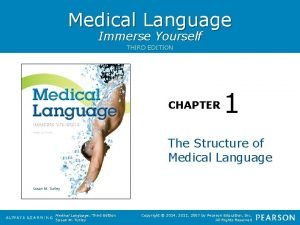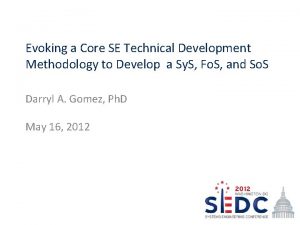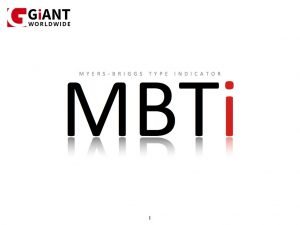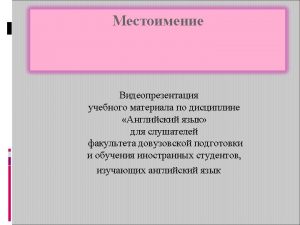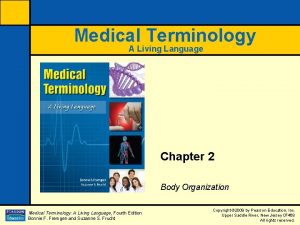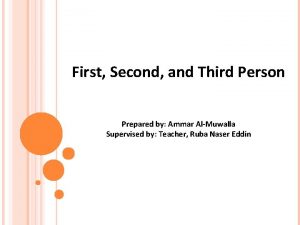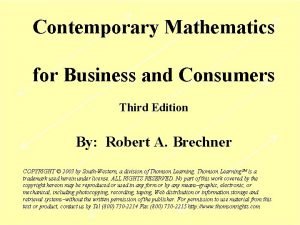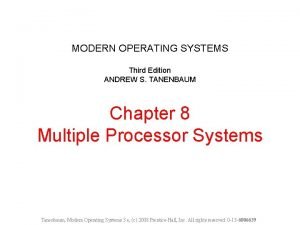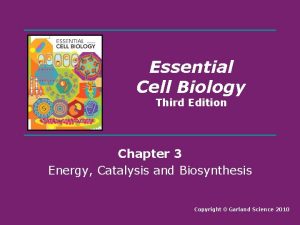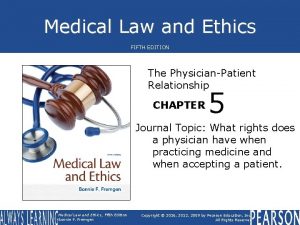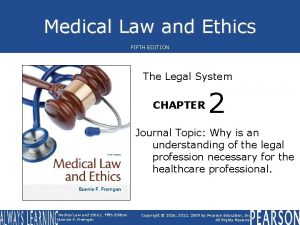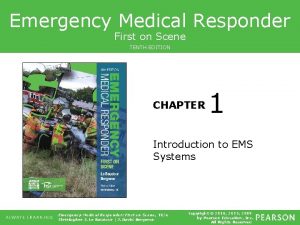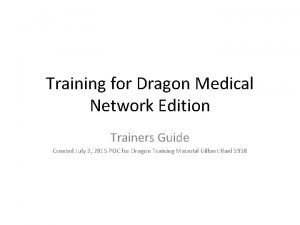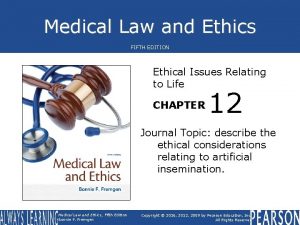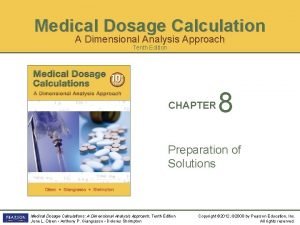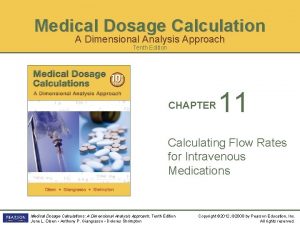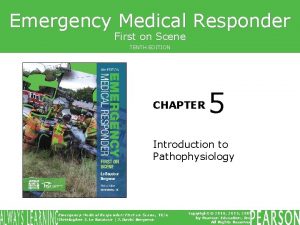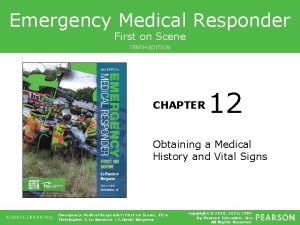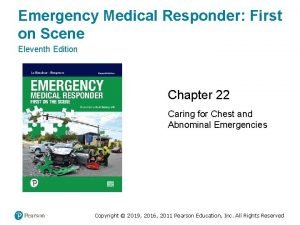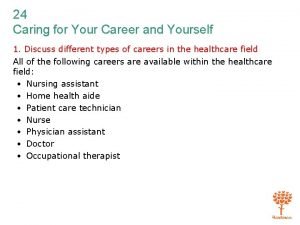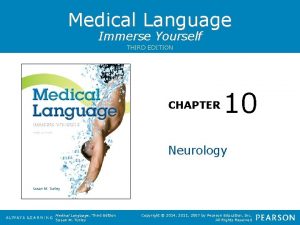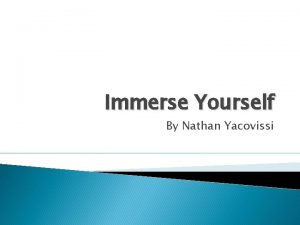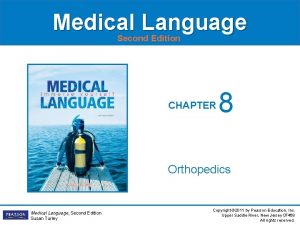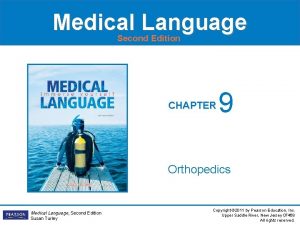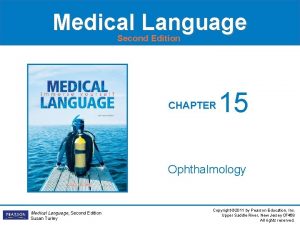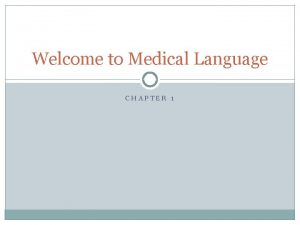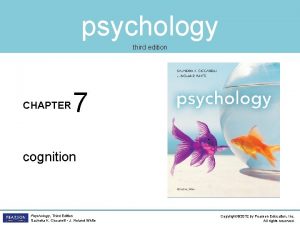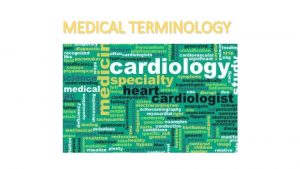Medical Language Immerse Yourself THIRD EDITION CHAPTER 1








































- Slides: 40

Medical Language Immerse Yourself THIRD EDITION CHAPTER 1 The Structure of Medical Language, Third Edition Susan M. Turley Copyright © 2014, 2011, 2007 by Pearson Education, Inc. All Rights Reserved

Classroom Response System Medical Language, Third Edition Susan M. Turley Copyright © 2014, 2011, 2007 by Pearson Education, Inc. All Rights Reserved

1 -4 Which of the following is an example of a combining form? A. intra. B. -ectomy C. ven/o. D. poly- Medical Language, Third Edition Susan M. Turley Copyright © 2014, 2011, 2007 by Pearson Education, Inc. All Rights Reserved

1 -4 Which of the following is an example of a combining form? A. intra. B. -ectomy C. ven/o. D. poly- Medical Language, Third Edition Susan M. Turley Copyright © 2014, 2011, 2007 by Pearson Education, Inc. All Rights Reserved

The medical word diverticulum is a Latin noun. To make the plural form, you would change the word ending -um to: 1 -6 A. -a B. -ices C. -us D. -ae Medical Language, Third Edition Susan M. Turley Copyright © 2014, 2011, 2007 by Pearson Education, Inc. All Rights Reserved

The medical word diverticulum is a Latin noun. To make the plural form, you would change the word ending -um to: 1 -6 A. -a B. -ices C. -us D. -ae Medical Language, Third Edition Susan M. Turley Copyright © 2014, 2011, 2007 by Pearson Education, Inc. All Rights Reserved

1 -4 The parts of medical words can include: A. combining forms. B. suffixes. C. prefixes. D. all of the above. Medical Language, Third Edition Susan M. Turley Copyright © 2014, 2011, 2007 by Pearson Education, Inc. All Rights Reserved

1 -4 The parts of medical words can include: A. combining forms. B. suffixes. C. prefixes. D. all of the above. Medical Language, Third Edition Susan M. Turley Copyright © 2014, 2011, 2007 by Pearson Education, Inc. All Rights Reserved

1 -4 A suffix is found at the beginning of the medical word. A. true B. false Medical Language, Third Edition Susan M. Turley Copyright © 2014, 2011, 2007 by Pearson Education, Inc. All Rights Reserved

1 -4 A suffix is found at the beginning of the medical word. A. true B. false Medical Language, Third Edition Susan M. Turley Copyright © 2014, 2011, 2007 by Pearson Education, Inc. All Rights Reserved

1 -4 A prefix: A. is always at the end of a medical word. B. is always at the beginning of a medical word. C. never ends in a vowel. D. never attaches to the beginning of a combining form. Medical Language, Third Edition Susan M. Turley Copyright © 2014, 2011, 2007 by Pearson Education, Inc. All Rights Reserved

1 -4 A prefix: A. is always at the end of a medical word. B. is always at the beginning of a medical word. C. never ends in a vowel. D. never attaches to the beginning of a combining form. Medical Language, Third Edition Susan M. Turley Copyright © 2014, 2011, 2007 by Pearson Education, Inc. All Rights Reserved

1 -4 A. a B. a C. a D. a The parts of a combining form include: root and a combining suffix. prefix. combining vowel and a prefix. Medical Language, Third Edition Susan M. Turley Copyright © 2014, 2011, 2007 by Pearson Education, Inc. All Rights Reserved

1 -4 The parts of a combining form include: A. a root and a suffix. B. a root and a prefix. C. a root and a combining vowel. D. a combining vowel and a prefix. Medical Language, Third Edition Susan M. Turley Copyright © 2014, 2011, 2007 by Pearson Education, Inc. All Rights Reserved

1 -4 Is the combining form found at the end of a medical word? A. yes B. no Medical Language, Third Edition Susan M. Turley Copyright © 2014, 2011, 2007 by Pearson Education, Inc. All Rights Reserved

1 -4 Is the combining form found at the end of a medical word? A. yes B. no Medical Language, Third Edition Susan M. Turley Copyright © 2014, 2011, 2007 by Pearson Education, Inc. All Rights Reserved

1 -4 The combining vowel gives meaning to the medical word. A. true B. false Medical Language, Third Edition Susan M. Turley Copyright © 2014, 2011, 2007 by Pearson Education, Inc. All Rights Reserved

1 -4 The combining vowel gives meaning to the medical word. A. true B. false Medical Language, Third Edition Susan M. Turley Copyright © 2014, 2011, 2007 by Pearson Education, Inc. All Rights Reserved

1 -5 In the medical word psychology, which part is the combining form? A. psych B. -logy C. -o D. psych/o- Medical Language, Third Edition Susan M. Turley Copyright © 2014, 2011, 2007 by Pearson Education, Inc. All Rights Reserved

1 -5 In the medical word psychology, which part is the combining form? A. psych B. -logy C. -o D. psych/o- Medical Language, Third Edition Susan M. Turley Copyright © 2014, 2011, 2007 by Pearson Education, Inc. All Rights Reserved

1 -4 Which is the most common combining vowel? A. a B. o C. e D. i Medical Language, Third Edition Susan M. Turley Copyright © 2014, 2011, 2007 by Pearson Education, Inc. All Rights Reserved

1 -4 Which is the most common combining vowel? A. a B. o C. e D. i Medical Language, Third Edition Susan M. Turley Copyright © 2014, 2011, 2007 by Pearson Education, Inc. All Rights Reserved

1 -4 A suffix, by itself, cannot be the foundation of a medical word. A. true B. false Medical Language, Third Edition Susan M. Turley Copyright © 2014, 2011, 2007 by Pearson Education, Inc. All Rights Reserved

1 -4 A suffix, by itself, cannot be the foundation of a medical word. A. true B. false Medical Language, Third Edition Susan M. Turley Copyright © 2014, 2011, 2007 by Pearson Education, Inc. All Rights Reserved

1 -5 The suffixes -ac, -al, -ary, and -ous all mean: A. a process; being or having. B. pertaining to. C. diagnosis. D. action; condition. Medical Language, Third Edition Susan M. Turley Copyright © 2014, 2011, 2007 by Pearson Education, Inc. All Rights Reserved

1 -5 The suffixes -ac, -al, -ary, and -ous all mean: A. a process; being or having. B. pertaining to. C. diagnosis. D. action; condition. Medical Language, Third Edition Susan M. Turley Copyright © 2014, 2011, 2007 by Pearson Education, Inc. All Rights Reserved

1 -5 Suffixes such as –iatry, -ist, and -logy describe: A. medical specialties or specialists. B. procedures or instruments. C. diseases. D. colors. Medical Language, Third Edition Susan M. Turley Copyright © 2014, 2011, 2007 by Pearson Education, Inc. All Rights Reserved

1 -5 Suffixes such as –iatry, -ist, and -logy describe: A. medical specialties or specialists. B. procedures or instruments. C. diseases. D. colors. Medical Language, Third Edition Susan M. Turley Copyright © 2014, 2011, 2007 by Pearson Education, Inc. All Rights Reserved

1 -6 Suffixes beginning with a consonant can be joined to the combining form by: A. adding an o to the beginning of the suffix before adding it to the combining form. B. keeping the combining form's combining vowel. C. adding an i to the beginning of the suffix before adding it to the combining form. D. dropping all vowels. Medical Language, Third Edition Susan M. Turley Copyright © 2014, 2011, 2007 by Pearson Education, Inc. All Rights Reserved

1 -6 Suffixes beginning with a consonant can be joined to the combining form by: A. adding an o to the beginning of the suffix before adding it to the combining form. B. keeping the combining form's combining vowel. C. adding an i to the beginning of the suffix before adding it to the combining form. D. dropping all vowels. Medical Language, Third Edition Susan M. Turley Copyright © 2014, 2011, 2007 by Pearson Education, Inc. All Rights Reserved

1 -5 Prefixes such as hyperand poly- indicate: A. time or speed. B. a characteristic. C. amount or number. D. weight. Medical Language, Third Edition Susan M. Turley Copyright © 2014, 2011, 2007 by Pearson Education, Inc. All Rights Reserved

1 -5 Prefixes such as hyperand poly- indicate: A. time or speed. B. a characteristic. C. amount or number. D. weight. Medical Language, Third Edition Susan M. Turley Copyright © 2014, 2011, 2007 by Pearson Education, Inc. All Rights Reserved

1 -5 In the medical word hypothyroidism, the suffix -ism means: A. a condition, state, or thing. B. pertaining to. C. a disease from a specific cause. D. medical treatment. Medical Language, Third Edition Susan M. Turley Copyright © 2014, 2011, 2007 by Pearson Education, Inc. All Rights Reserved

1 -5 In the medical word hypothyroidism, the suffix -ism means: A. a condition; state; thing. B. pertaining to. C. a disease from a specific cause. D. medical treatment. Medical Language, Third Edition Susan M. Turley Copyright © 2014, 2011, 2007 by Pearson Education, Inc. All Rights Reserved

1 -5 Which suffix means process of recording? A. -pathy B. -graphy C. -ation D. -iatry Medical Language, Third Edition Susan M. Turley Copyright © 2014, 2011, 2007 by Pearson Education, Inc. All Rights Reserved

1 -5 Which suffix means process of recording? A. -pathy B. -graphy C. -ation D. -iatry Medical Language, Third Edition Susan M. Turley Copyright © 2014, 2011, 2007 by Pearson Education, Inc. All Rights Reserved

1 -6 Medical words must be defined by analyzing them, beginning with the: A. prefix. B. combining form. C. suffix. D. latin part of the word. Medical Language, Third Edition Susan M. Turley Copyright © 2014, 2011, 2007 by Pearson Education, Inc. All Rights Reserved

1 -6 Medical words must be defined by analyzing them, beginning with the: A. prefix. B. combining form. C. suffix. D. latin part of the word. Medical Language, Third Edition Susan M. Turley Copyright © 2014, 2011, 2007 by Pearson Education, Inc. All Rights Reserved

1 -4 Which of the following is an example of a suffix? A. -ia B. post. C. dys. D. nas/o- Medical Language, Third Edition Susan M. Turley Copyright © 2014, 2011, 2007 by Pearson Education, Inc. All Rights Reserved

1 -4 Which of the following is an example of a suffix? A. -ia B. post. C. dys. D. nas/o- Medical Language, Third Edition Susan M. Turley Copyright © 2014, 2011, 2007 by Pearson Education, Inc. All Rights Reserved
 Medical language immerse yourself
Medical language immerse yourself Immerse
Immerse Know yourself to lead yourself
Know yourself to lead yourself Check yourself before you wreck yourself origin
Check yourself before you wreck yourself origin Myself yourself himself herself
Myself yourself himself herself Youtube yourself broadcast yourself
Youtube yourself broadcast yourself Medical terminology a living language 6th edition
Medical terminology a living language 6th edition Talking in third person example
Talking in third person example Confession
Confession Gj mount classification
Gj mount classification Caries on lingual surfaces of maxillary incisors
Caries on lingual surfaces of maxillary incisors Principle of economics third edition
Principle of economics third edition Reaction of grignard reagent with acid chloride
Reaction of grignard reagent with acid chloride Organic chemistry third edition david klein
Organic chemistry third edition david klein Business mathematics third edition
Business mathematics third edition Distributed systems third edition
Distributed systems third edition Fundamentals of corporate finance third canadian edition
Fundamentals of corporate finance third canadian edition Sujata madan
Sujata madan Lifespan development third edition
Lifespan development third edition Lifespan development third edition
Lifespan development third edition Essential cell biology third edition
Essential cell biology third edition Dr ruth yates
Dr ruth yates Mis chapter 6
Mis chapter 6 Using mis (10th edition) 10th edition
Using mis (10th edition) 10th edition Medical law and ethics 5th edition
Medical law and ethics 5th edition Medical law and ethics 5th edition
Medical law and ethics 5th edition Emergency medical responder first on scene
Emergency medical responder first on scene Dragon medical one tutorial
Dragon medical one tutorial Medical law and ethics 5th edition
Medical law and ethics 5th edition Sustical
Sustical Medical dosage calculations a dimensional analysis approach
Medical dosage calculations a dimensional analysis approach Emergency medical responder first on scene 10th edition
Emergency medical responder first on scene 10th edition Antecubital
Antecubital Emergency medical responder first on scene 11th edition
Emergency medical responder first on scene 11th edition Snap back to reality lyrics
Snap back to reality lyrics California medical license for foreign medical graduates
California medical license for foreign medical graduates Gbmc infoweb
Gbmc infoweb Difference between medical report and medical certificate
Difference between medical report and medical certificate Torrance memorial medical records
Torrance memorial medical records Cartersville medical center medical records
Cartersville medical center medical records Chapter 31 caring for your career and yourself
Chapter 31 caring for your career and yourself
